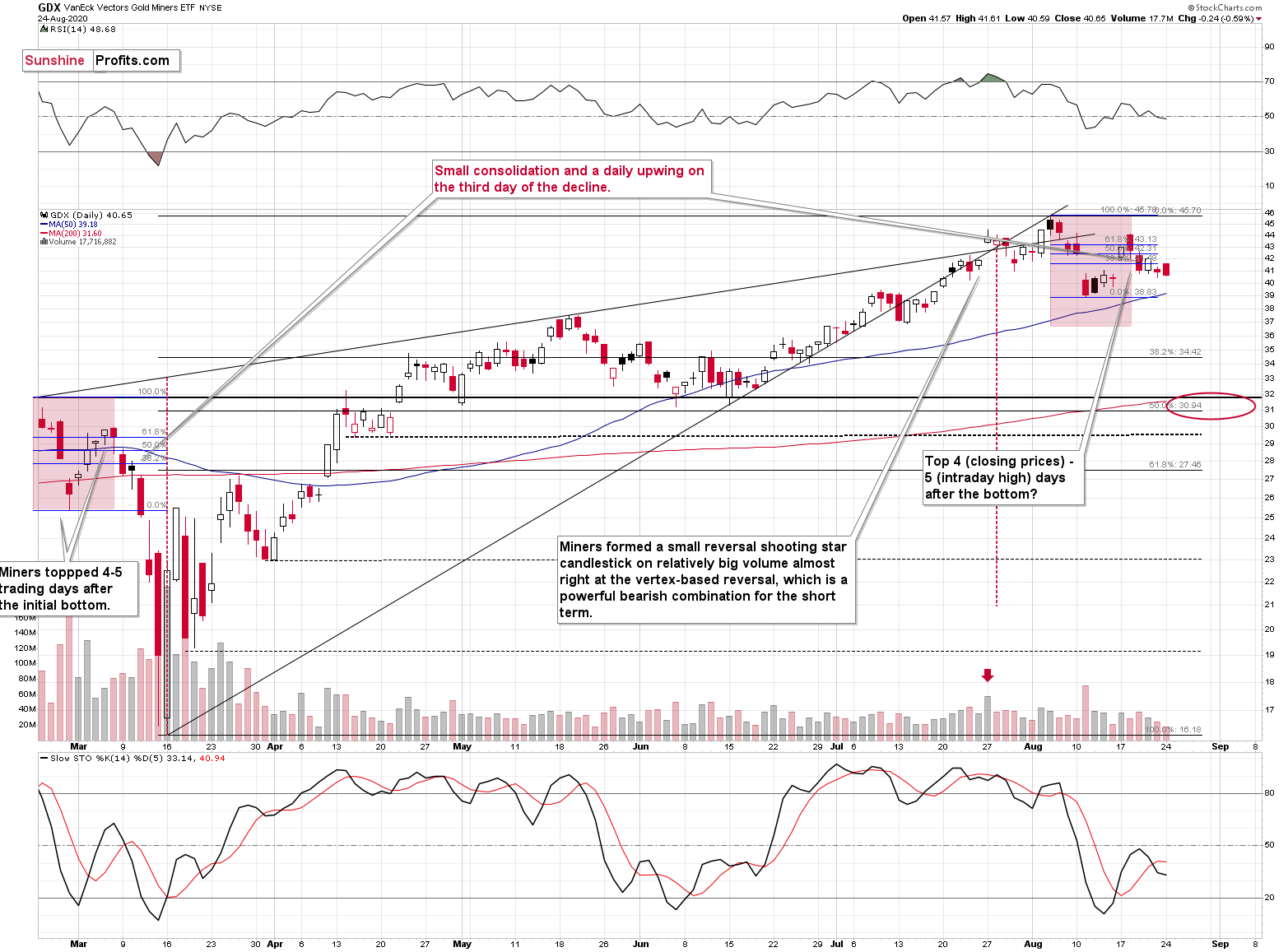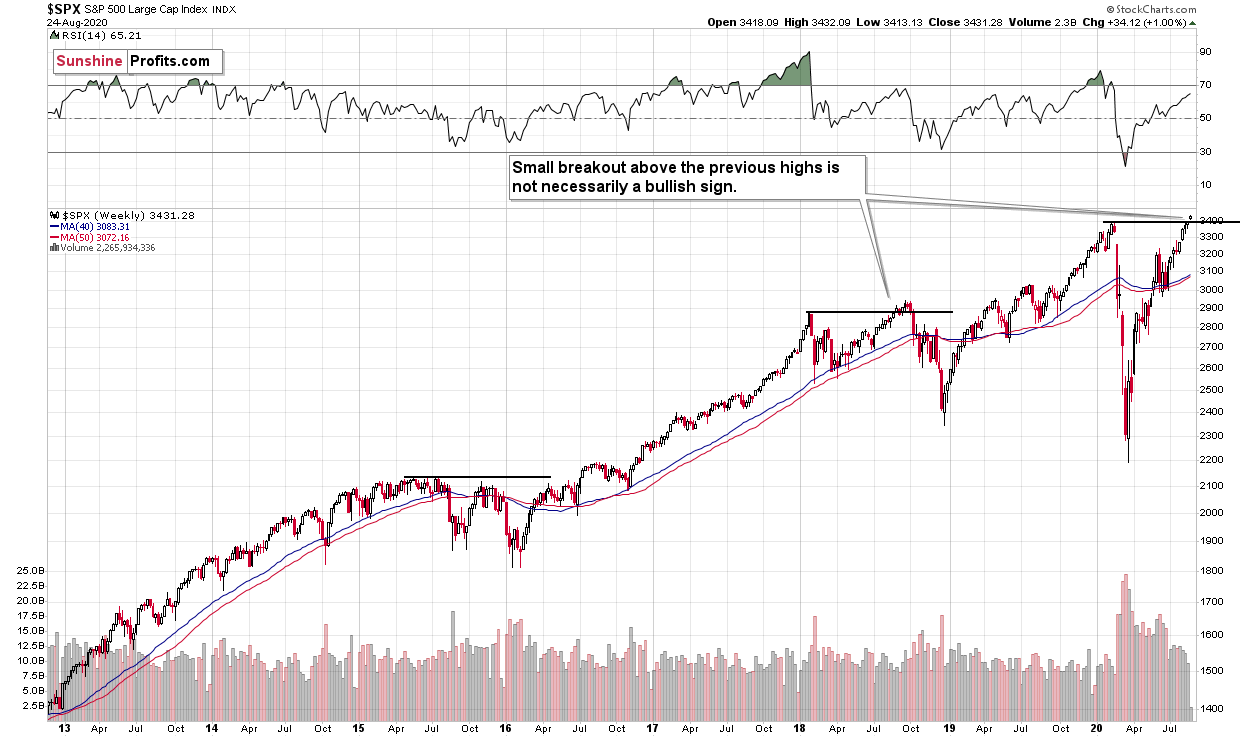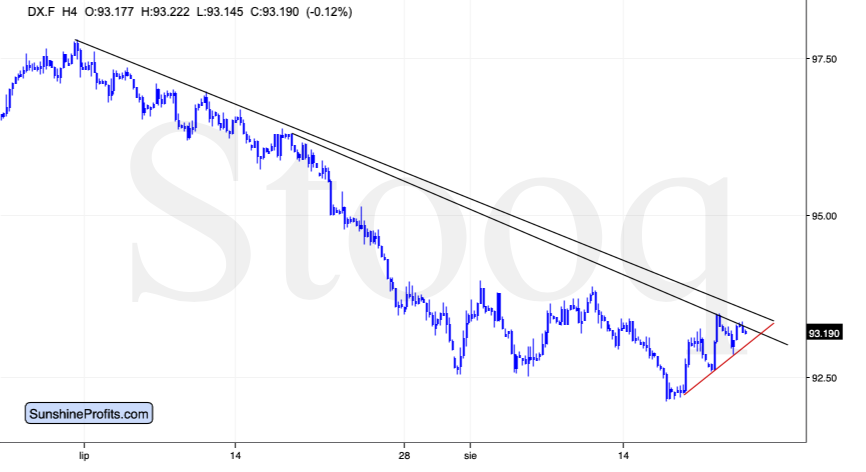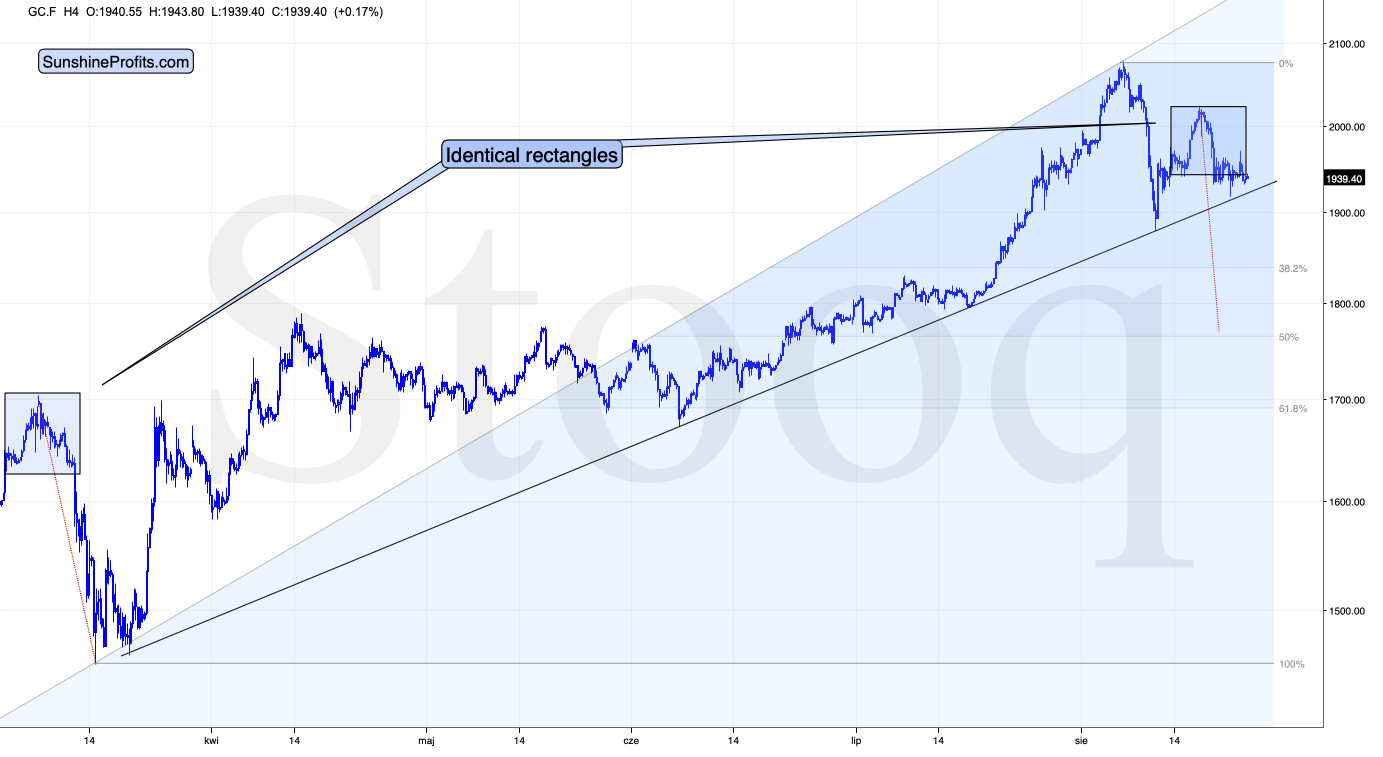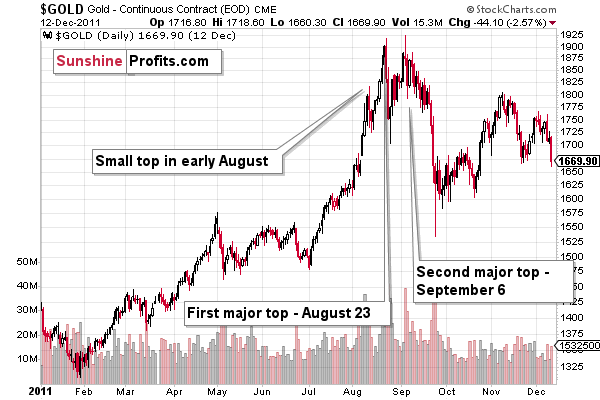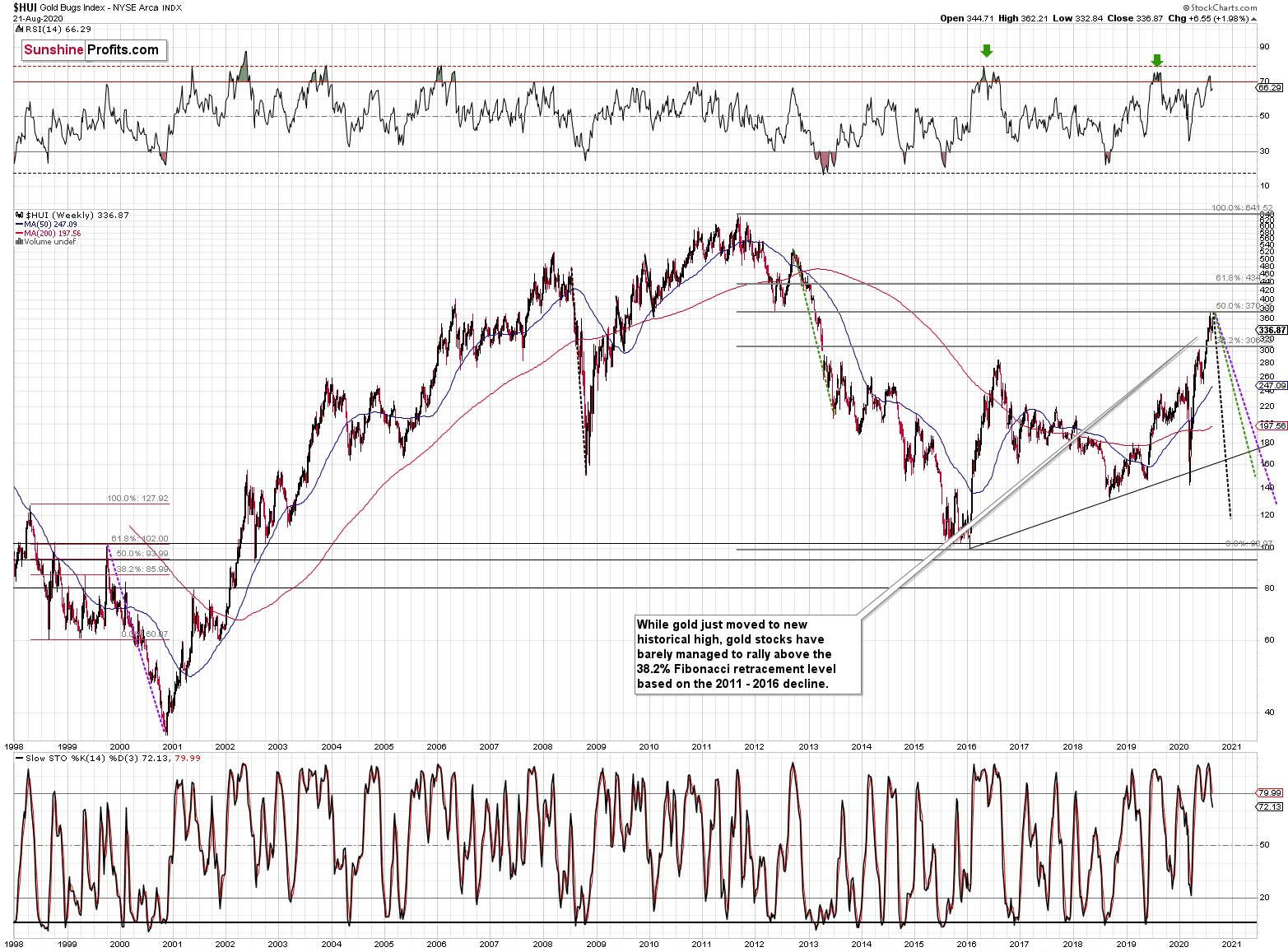Briefly: in our opinion, full (300% of the regular position size) speculative short positions in mining stocks are justified from the risk/reward point of view at the moment of publishing this Alert.
Mining stocks moved lower yesterday, but not significantly so. In yesterday's analysis we warned that this could take place (instead of the volatile plunge that we saw in March) because of the strong performance of the general stock market. We wrote the following:
Last week, gold stocks rallied initially, but erased almost all of their gains before the week was over. Most interestingly, that's very much in tune with what happened in March.
Back then, on the third day of the decline - on March 10th - we saw a small daily upswing, which was just a daily pause right before the biggest part of the move.
We saw the same thing on Thursday. The GDX ETF moved a bit higher and it was the third day of the decline.
Just as we saw on March 10th, GDX moved higher on volume that was slightly lower than what we saw on the previous trading day.
On Friday - the fourth day of the decline - miners declined, more than erasing the previous day's gains. This is exactly what happened on March 11th - the fourth day of the previous decline.
The self-similarity remains intact and the implications remain very bearish.
Now, since the general stock market moved above the previous highs and continues to rally, we might or might not see a sizable decline early this week. Back in March, the slide in miners corresponded to the decline in the general stock market, and this could be repeated, or we could see some sideways trading after the slide resumes, once stocks finally decline.
Still, at this time, the implications of the above chart are very bearish.
The above remains up-to-date. Miners declined despite a quite visible move higher in stocks, which doesn't bode well for the former.
The S&P 500 has just moved slightly above previous 2020 high.
Given the economic background, I find this performance unfounded. But the markets can stick to a certain emotional trend for longer than many investors can remain logical, which would fit the above picture.
Back in 2015 stocks topped below their previous highs, and in 2018 they topped a bit above them, so the proximity to the previous is far from being a precise sell signal. It does indicate, that the stock market is likely vulnerable to sell signals coming from other markets and that this emotional rally could end sooner rather than later.
Do you remember what happened in February when the S&P 500 lost its upward momentum? They plunged, and that was when tops in mining stocks and silver formed. Gold made another attempt to move higher but ultimately declined profoundly in the following days.
It appears that on one hand, everything that could have gone well for gold on the fundamental front, has already gone well [maybe the tone of the just-released minutes, which were dovish, but less dovish than expected], and it already rallied, and on the other hand, we have many signals pointing to the situation being excessive. This means that as some of the bullish factors ease (perhaps temporarily) and investors get scared about economy's ability to really recover, gold is likely to correct significantly, before continuing its upward march.
Just like the invalidation of the small breakout led to a powerful decline in late 2018, I expect something similar to happen also this time. It will be most likely the case that when the stock market reverses, that mining stocks' decline accelerates.
Meanwhile, the situation in gold and the USD Index continues to suggest that lower prices are just around the corner.
The U.S. currency is moving higher after invalidating the breakdown below the previous lows. It then tried moving lower once again, but bounced off the late-July and early-August lows. This is a positive sign. The current very short-term decline is nothing to be concerned about as it didn't even take the USD Index below the rising red support line based on two most recent lows.
In fact, the USDX bounced off the red support line yesterday.
Given the long-term chart featured previously and the short-term invalidation, it seems that the outlook for the USDX is very bullish. Still, until the index breaks above the declining black resistance line and the August highs, it won't be clear to most traders. Consequently, we expect to see the biggest rally in the USDX - and the biggest decline in gold - once we see the above-mentioned breakout.
Back in March, the short-term breakout in the USD Index was the thing that triggered the powerful rally in it, as well as a powerful plunge in the precious metals market.
Let's turn to metals themselves.
Gold's performance continues to be very similar to what happened in early March and the 4-hour candlestick chart shows the details.
The short-term gold chart confirms the self-similarity that miners indicate. The areas marked with blue rectangles are similarly shaped and they happened at similar times, if we consider what the USD Index had been doing in both cases.
The two blue rectangles are identical (copy-pasted), which makes it even clearer that the history is rhyming. The sizes of the moves in terms of price and time are very similar.
Unlike what we saw in March, this time, gold didn't move back to its previous high, but this doesn't invalidate the entire analogy.
To be clear, we could still see a move back to the previous high, but it seems more likely that since we already saw two distinct tops, there would be no third top. This way, the double-top pattern would be similar to what happened in March and in 2011, but we wouldn't have the similarity in terms of the price levels that were reached.
As a reminder, here's what happened in 2011.
The additional similarity between now, March 2020, and the 2011 top, is that gold's pace of decline diminished after the second top.
The next support is at $1,700, which is where - approximately - gold topped and bottomed multiple times earlier this year.
Before summarizing, we would like to address a few questions that we received recently:
From the Readers' Mailbag
Q: Hi PR,
I am enjoying your news letters and thank you for what you do. You mention in your news letters the target price of $1703 for the upcoming Gold decline. Could you please include your Silver forecast also?
Thanks!
A: Thank you as well - I'm happy to read that you're enjoying my analyses. In general, I'm not emphasizing the forecast for silver, because it's not as clear as the one for gold. Sometimes, a given market has a rather clear technical picture as far as price targets are concerned, and sometimes it doesn't. For instance, if several target-determining techniques point to the same thing, or one of them is particularly strong as it was proven as useful multiple times. In case of gold, the technical picture is relatively clear, but in case of silver, not so much.
If gold declines to about $1,700, it seems that silver would decline to about $19 - $20, however, we would be paying more attention to gold than to silver, even when trading silver, as they are both likely to bottom at the same time (just like they did in March).
Q: P.R.
What ETF is available to short the silver market?
DSLV has been discontinued.
Thanks.
A: For instance, the ZSL.
In general, as far as using leverage or shorting gold and/or silver is concerned through ETF/ETNs, I think that ProShares instruments are worth looking at. By that I don't mean that they are appropriate for everyone, and this should not be treated as an investment advice, but these investment vehicles are liquid and they provide significant exposure for the prices of the underlying metals.
The symbols are:
- UGL - 2x long gold
- GLL - 2x short gold
- AGQ - 2x long silver
- ZSL - 2x short silver
Q: Why are so many miners, with gold even higher than in '07 and '11 not at their previous highs or even higher? Not even with this being overbought status.
I mean, you must know EGO and IAG's charts by heart. They are 400/500% below their previous highs with gold this time even higher...
And secondly: what has to happen to push EGO, IAG, GPL, AXU etcetera on a broader picture level and on a technical level to their respective alltime highs out of the past? (not company specific)
A: Most likely because of the somewhat artificial nature of this upswing in the precious metals market. In a true bull market, the mining stocks should be leading the way higher, just like what we saw between late 2000 and 2004.
Neither silver, nor mining stocks are making new highs (they didn't rally more than 50% of what they declined from their 2011 tops). Why? Gold is dragging the entire sector higher most likely due to the aftermath of the Covid-19 shock. If it wasn't for that, gold would probably be trading much lower, likely testing $1,200 - $1,400 right now, on its way to even lower levels. Or it would be already after the dramatic plunge and on the rebound.
The mining stocks seem to be unwilling to really rally until the broken (based on the Covid-19 crisis) cycle is completed. What would it take for the miners to rally in their normal way? Probably another sizable decline that would complete the bearish cycle. Of course, given gold's move above the 2011 highs, it's difficult to see the bearish cycle directly, but its signs are visible in silver and miners.
Once PMs and miners slide significantly one more time while the USD Index soars, and then they manage to rebound and rally, even though the USDX will still be moving higher, we will have gotten a solid probability that the miners would be rallying in their "normal way". The "normal way" here means that they would magnify gold's gains, especially during the initial part of the upswing.
Overview of the Upcoming Decline
As far as the current overview of the upcoming decline is concerned, I think that it has already begun, at least in case of the mining stocks. It's still relatively unclear if gold makes another attempt to move to new highs before plunging below $1,800, but it now appears more likely that it won't.
During the final part of the slide, we expect silver to decline more than miners. That would be in tune with how the markets initially reacted to the Covid-19 threat.
The impact of all the new rounds of money printing in the U.S. and Europe on the precious metals prices is very positive in the long run, but it doesn't make the short-term decline unlikely. In the very near term, markets can and do get ahead of themselves and then need to decline - sometimes very profoundly - before continuing their upward march.
Summary
Summing up, it seems that after reversing $4 above our upside target, gold has finally topped, and that it formed the second top from the double-top pattern last week. The opposite appears likely in case of the USD Index, which just invalidated its breakdown below the previous lows. This creates a very bearish environment for the precious metals market, especially for the mining stocks. The decline in the latter is likely to accelerate once the general stock market finally declines.
Naturally, everyone's trading is their responsibility, but in our opinion, if there ever was a time to either enter a short position in the miners or to increase its size if it wasn't already sizable, it's now. We made money on the March decline and on the March rebound, and it seems that another massive slide is about to start. When everyone is on one side of the boat, it's a good idea to be on the other side, and the Gold Miners Bullish Percent Index literally indicates that this is the case with mining stocks.
After the sell-off (that takes gold to about $1,700 or lower), we expect the precious metals to rally significantly. The final decline might take as little as 1-6 weeks, so it's important to stay alert to any changes.
Most importantly - stay healthy and safe. We made a lot of money on the March decline and the subsequent rebound (its initial part) price moves (and we'll likely make much more in the following weeks and months), but you have to be healthy to really enjoy the results.
As always, we'll keep you - our subscribers - informed.
To summarize:
Trading capital (supplementary part of the portfolio; our opinion): Full speculative short positions (300% of the full position) in mining stocks is justified from the risk to reward point of view with the following binding exit profit-take price levels:
Senior mining stocks (price levels for the GDX ETF): binding profit-take exit price: $32.02; stop-loss: none (the volatility is too big to justify a SL order in case of this particular trade); binding profit-take level for the DUST ETF: $28.73; stop-loss for the DUST ETF: none (the volatility is too big to justify a SL order in case of this particular trade)
Junior mining stocks (price levels for the GDXJ ETF): binding profit-take exit price: $42.72; stop-loss: none (the volatility is too big to justify a SL order in case of this particular trade); binding profit-take level for the JDST ETF: $21.22; stop-loss for the JDST ETF: none (the volatility is too big to justify a SL order in case of this particular trade)
For-your-information targets (our opinion; we continue to think that mining stocks are the preferred way of taking advantage of the upcoming price move, but if for whatever reason one wants / has to use silver or gold for this trade, we are providing the details anyway. In our view, silver has greater potential than gold does):
Silver futures downside profit-take exit price: unclear at this time - initially, it might be a good idea to exit, when gold moves to $1,703.
Gold futures downside profit-take exit price: $1,703
Long-term capital (core part of the portfolio; our opinion): No positions (in other words: cash
Insurance capital (core part of the portfolio; our opinion): Full position
Whether you already subscribed or not, we encourage you to find out how to make the most of our alerts and read our replies to the most common alert-and-gold-trading-related-questions.
Please note that the in the trading section we describe the situation for the day that the alert is posted. In other words, it we are writing about a speculative position, it means that it is up-to-date on the day it was posted. We are also featuring the initial target prices, so that you can decide whether keeping a position on a given day is something that is in tune with your approach (some moves are too small for medium-term traders and some might appear too big for day-traders).
Plus, you might want to read why our stop-loss orders are usually relatively far from the current price.
Please note that a full position doesn't mean using all of the capital for a given trade. You will find details on our thoughts on gold portfolio structuring in the Key Insights section on our website.
As a reminder - "initial target price" means exactly that - an "initial" one, it's not a price level at which we suggest closing positions. If this becomes the case (like it did in the previous trade) we will refer to these levels as levels of exit orders (exactly as we've done previously). Stop-loss levels, however, are naturally not "initial", but something that, in our opinion, might be entered as an order.
Since it is impossible to synchronize target prices and stop-loss levels for all the ETFs and ETNs with the main markets that we provide these levels for (gold, silver and mining stocks - the GDX ETF), the stop-loss levels and target prices for other ETNs and ETF (among other: UGLD, DGLD, USLV, DSLV, NUGT, DUST, JNUG, JDST) are provided as supplementary, and not as "final". This means that if a stop-loss or a target level is reached for any of the "additional instruments" (DGLD for instance), but not for the "main instrument" (gold in this case), we will view positions in both gold and DGLD as still open and the stop-loss for DGLD would have to be moved lower. On the other hand, if gold moves to a stop-loss level but DGLD doesn't, then we will view both positions (in gold and DGLD) as closed. In other words, since it's not possible to be 100% certain that each related instrument moves to a given level when the underlying instrument does, we can't provide levels that would be binding. The levels that we do provide are our best estimate of the levels that will correspond to the levels in the underlying assets, but it will be the underlying assets that one will need to focus on regarding the signs pointing to closing a given position or keeping it open. We might adjust the levels in the "additional instruments" without adjusting the levels in the "main instruments", which will simply mean that we have improved our estimation of these levels, not that we changed our outlook on the markets. We are already working on a tool that would update these levels on a daily basis for the most popular ETFs, ETNs and individual mining stocks.
Our preferred ways to invest in and to trade gold along with the reasoning can be found in the how to buy gold section. Additionally, our preferred ETFs and ETNs can be found in our Gold & Silver ETF Ranking.
As a reminder, Gold & Silver Trading Alerts are posted before or on each trading day (we usually post them before the opening bell, but we don't promise doing that each day). If there's anything urgent, we will send you an additional small alert before posting the main one.
Thank you.
Sincerely,
Przemyslaw Radomski, CFA
Editor-in-chief, Gold & Silver Fund Manager


